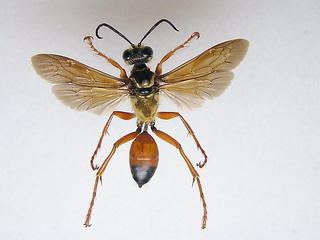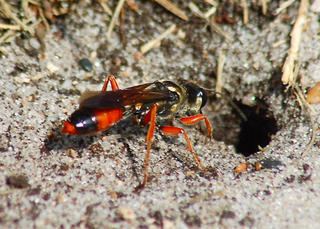Scientific name Sphex Higher classification Sphecini Order Hymenopterans | Tribe Sphecini Rank Genus | |
 | ||
Similar | ||
Great golden digger wasp sphex experiment 1
Wasps of the genus Sphex (commonly known as digger wasps) are cosmopolitan predators that sting and paralyze prey insects. Sphex is one of many genera in the old digger wasp family Sphecidae (sensu lato), though most apart from the Spaciness have now been moved to the family Crabronidae. There are over 130 known Sphex species.
Contents
- Great golden digger wasp sphex experiment 1
- Ceriana wasp wasp mimic hoverfly hymenoptera ceriana sp sphex viduatus christ
- Behaviour
- Uses in philosophy
- Species
- References

Ceriana wasp wasp mimic hoverfly hymenoptera ceriana sp sphex viduatus christ
Behaviour

In preparation for egg laying, they construct a protected "nest" (some species dig nests in the ground, while others use pre-existing holes) and then stock it with captured insects. Typically, the prey are left alive, but paralyzed by wasp toxins. The wasps lay their eggs in the provisioned nest and the wasp larvae feed on the paralyzed insects as they develop.

The great golden digger wasp (Sphex ichneumoneus) is found in North America. The developing wasps spend the winter in their nest. When the new generation of adults emerge, they contain the genetically programmed behaviors required to carry out another season of nest building. During the summer, a female might build as many as six nests, each with several compartments for her eggs. The building and provisioning of the nests takes place in a stereotypical, step-by-step fashion.

Sphex has been shown, as in some Jean Henri Fabre studies, not to count how many crickets it collects for its nest. Although the wasp instinctively searches for four crickets, it cannot take into account a lost cricket, whether the cricket has been lost to ants or flies or simply been misplaced. Sphex drags its cricket prey towards its burrow by the antennae; if the antennae of the cricket are cut off, the wasp would not think to continue to pull its prey by a leg.

The navigation abilities of Sphex were studied by the ethologist Niko Tinbergen. Richard Dawkins and Jane Brockmann later studied female rivalry over nesting holes in Sphex ichneumoneus.
Uses in philosophy
Some writers in the philosophy of mind, most notably Daniel Dennett, have cited Sphex's behavior for their arguments about human and animal free will.
Some Sphex wasps drop a paralyzed insect near the opening of the nest. Before taking provisions into the nest, the Sphex first inspects the nest, leaving the prey outside. During the inspection, an experimenter can move the prey a few inches away from the opening. When the Sphex emerges from the nest ready to drag in the prey, it finds the prey missing. The Sphex quickly locates the moved prey, but now its behavioral "program" has been reset. After dragging the prey back to the opening of the nest, once again the Sphex is compelled to inspect the nest, so the prey is again dropped and left outside during another stereotypical inspection of the nest. This iteration can be repeated several times without the Sphex changing its sequence; by some accounts, endlessly. Dennett's argument quotes an account of Sphex behavior from Dean Wooldridge's Machinery of the Brain (1963). Douglas Hofstadter and Daniel Dennett have used this mechanistic behavior as an example of how seemingly thoughtful behavior can actually be quite mindless, the opposite of free will (or, as Hofstadter described it, sphexishness).
Philosopher Fred Keijzer challenges this use of Sphex, citing experiments in which behavioral adaptations are observed after many iterations. Keijzer sees the persistence of the Sphex example in cognitive theory as an indication of its rhetorical usefulness, not its factual accuracy.
Species
The genus Sphex contains over 100 species:
